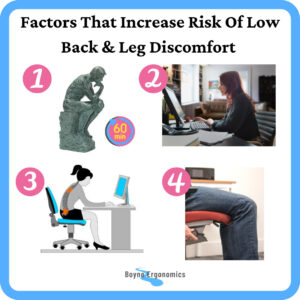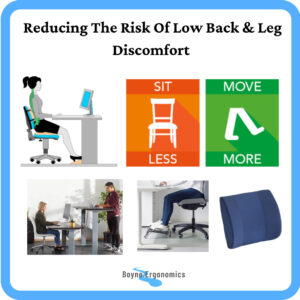There is no doubt that low back and leg pain is a significant issue for people that work in computer and desk based jobs. This discomfort may be present both at the workstation and away from it and can impact quality of life outside of work.
There are many causes of low back and leg pain, including trauma, degenerative changes and underlying medical conditions. While the workstation and DSE based role may not always be the cause of the issue, there are risk factors present at the DSE workstation that aggravate and contribute to the development of low back and leg discomfort.
In this blog post, I am going to identify the potential causes of low back and leg discomfort associated with desk-based jobs and the steps you can take to reduce the risk of developing these issues.
Factors That Increase The Risk of Low Back and Leg Discomfort at the DSE Workstation
There are a number of factors present in desk-based roles that can increase the risk of developing discomfort in the lower back and legs.
- Prolonged Static Postures
Static static postures require continuous contraction of the muscles of the hips and back. This continuous contraction, or loading, in a fixed position results in reduced blood flow in the muscles, meaning that waste products cannot be removed effectively and oxygen and nutrients cannot be distributed efficiently. This causes fatigue and discomfort in the musculoskeletal system, which can contribute to those aches and pains you feel at the workstation.
Sitting increases the pressure on the intervertebral discs in the lower back, as they are being compressed from above and below. The level of pressure on the discs varies based on seated position, ranging from 140% of standing pressure when seated upright to 190% of standing pressure when leaning forward. Prolonged sitting also reduces the pumping action required to provide the discs with nutrients that can help reduce degenerative changes.
Sitting causes imbalances in our core stabiliser muscles due to the overuse of some muscles, but low activation of others. The abdominals can weaken while the lower back muscles tighten. The glutes can weaken and the hamstrings and hip flexors tighten. These imbalances, over time, can affect alignment, posture and cause pain in the lower back.
Prolonged static standing can impact the lower limbs in particular. Reduced blood flow and circulation can cause fluid pooling in the legs, pressure on the veins and discomfort.
- Inadequate Lumbar Support
The lower back comes under a lot of pressure and strain when seated.
A lack of lumbar support can arise due to inappropriate seating at the workstation, such as a dining chair or swivel chair with a fixed backrest, or by the incorrect placement of the lumbar support of the DSE office chair.
- Adverse Postures
Adverse postures refer to postures that put excessive strain on the musculoskeletal system. They occur at the workstation due to incorrect positioning, inappropriate equipment, fatigue and bad habits!
Common desk related adverse postures include being seated at the incorrect height for the work surface, the work surface being the wrong height for your standing position, hunching forward and looking down at the laptop, sliding forward in the seat and crossing your legs when seated.
These postures put excessive stress on the spine, discs and tissues and increased strain on the back and hip muscles.
- Contact Stress
Contact stress that can impact discomfort in the legs usually comes from the seat pan.
If the seat pan is too deep for your stature, it will come into contact with the back of your knees when you sit back against the backrest.
If you are seated too high for your stature and do not have a solid base under your feet, there can be an increased pressure between the seat pan and your thighs. This can negatively impact circulation to the lower limbs.
If the seat pan has a hard surface or lacks appropriate padding, this can increase pressure between the seat pan and your thighs.
Any of these factors can negatively affect the circulation to the lower limbs, causing discomfort in the legs, ankles and feet.

Reducing The Factors That Increase The Risk of Low Back and Leg Discomfort at the DSE Workstation
- Reduce Prolonged Seating
I recommend taking regular microbreaks from the workstation every 45 minutes to decompress the discs in the lower back, activate the glutes and core, relieve tension in the back and shoulder muscles and increase circulation.
If using a sit stand workstation, ensure to change posture regularly. Avoid prolonged static standing and take regular microbreaks to boost circulation.
Take calls on the move when you can and a wireless headset can be a great tool to allow frequent movement from the desk during virtual meetings when working from home.
- Ensure the Lower Back is Supported
If using a chair with a backrest that cannot be adjusted, add additional cushioning or a lumbar support that can be positioned in the lumbar spine.
If using a DSE appropriate office chair, ensure that the backrest or lumbar support height is adjusted to position the lumbar pump in the lower back. Ensure the recline is adjusted so that your back rests against the backrest when in the typing position.
- Reduce Adverse Postures
To reduce adverse postures at the desk, ensure you are seated at the right height for the surface, with shoulders relaxed and elbows level with the surface and support underfoot if required. Use a footrest if required.
Ensure the monitors are at the right height to allow you to rest your eyes on the top third of the screen when your ears are over your shoulder. If using a laptop or tablet, use an external keyboard and mouse to allow you to raise it up to an appropriate height.
Keep the keyboard, mouse and any frequent use equipment close to you to reduce reaching and forward leaning postures.
Sit back in the chair, with your back in contact with the backrest. Avoid crossing the legs, using a footrest or foam roller to facilitate lower limb movement at the desk.
- Reduce Contact Stress
To reduce contact stress when seated at the workstation, ensure that you have support underfoot if you cannot plant your heels on the floor. Use a footrest if required.
If the seat pan comes into contact with the back of your knees, consider reducing the depth of the seat pan by adding a foam backrest or cushion.
If the seat pan is too hard, add additional cushioning or a foam seat wedge to reduce contact stress and pressure on the thighs.

While low back and leg discomfort may not always be caused by the working at a desk, desk-based DSE roles can aggravate any underlying conditions or injuries.
An active, healthy lifestyle, incorporating Pilates and Yoga, can help address some of the risks associated with sedentary roles. If you start to develop low back or leg discomfort, that persists and starts to impact your functional ability, you should get in touch with your doctor or physiotherapist to try to identify the cause and offer treatment solutions.
It is important that any work-related discomfort is reported to your employer, addressed as early as possible and an ergonomic risk assessment is completed to reduce levels of discomfort and long term impact.
Sources
https://oshwiki.eu/wiki/Musculoskeletal_disorders_in_visual_display_unit_(VDU)_tasks
https://www.hse.gov.uk/research/rrhtm/rr561.htm https://www.ncbi.nlm.nih.gov/pmc/articles/PMC7186678/


